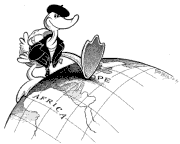A Beginner's Guide to Effective Email
Page Layout
Kaitlin Duck SherwoodWords on a computer screen look different than on paper, and usually people find it harder to read things on a screen than on paper. (I know several people who even print out their email to read it.) The screen's resolution is not as good as paper's, there is sometimes flicker, the font may be smaller, and/or the font may be ugly. Your recipient's email reader may also impose some constraints upon the formatting of the mail, and may not have the same capabilities as your email software. This means that good email page layout is different from good paper document page layout.
Shorter Paragraphs
Frequently email messages will be read in a document window with scrollbars. While scrollbars are nice, it makes it harder to visually track long paragraphs. Consider breaking up your paragraphs to only a few sentences apiece.
Line Length
Some software to read mail does not automatically wrap (adjust what words go on what line). This means that if there is a mismatch between your software's and your correspondent's in how they wrap lines, your correspondent may end up with a message that looks like this:I've got the price quote for the Cobra subassembly ready; as soon as I get a decision on the thromblemeister selection, I'll be ready to go. Have you talked to the thermo guys about whether they are ready to go with the left-handed thrombo or do they want to wait and check out the right-handed one first?
Furthermore, the "quoted-printable" encoding also contributes to the line-length problems. If a line is longer than 76 characters, it is split after the 75th character and the line ends with an equals sign. People whose email reading software can understand quoted-printable encoding will probably have the lines automatically reconstructed, but others will see ugly messages, like the following:
I've got the price quote for the Cobra subassemby ready; as soon as I get a= decision on the thromblemeister selection, I'll be ready to go. Have you= talked to the thermo guys about whether they are ready to go with the= left-handed thrombo or do they want to wait and check out the right-handed= one first?
There are even a few email readers that truncate everything past the eightieth character. This is not the way to win friends and influence people.
You should try to keep your lines under seventy characters long. Why seventy and not, say, seventy-six? Because you should leave a little room for the indentation or quote marks your correspondents may want if they need to quote pieces of your message in their replies.
Terser Prose
How many times when you were in school were you told to write a 20-page paper? Probably a lot, and you got penalized for being terse. This training is not appropriate for email. Keep it short. If they want more information, they can ask for it. (Also note that some of your correspondents may be charged by the kilobyte and/or have limits on how much disk space their email can use!)If you are sending a report to many people, then you may need to put more detail into the email so that you aren't flooded with questions from everyone on the recipient list. (You should also ask yourself carefully if all the people really need to be on the list.)
The fewer the people there are on the recipient list, the shorter the message should be. Books to thousands of people are tens of thousands of words long. Speeches in front of large groups are thousands of words long. But you'd tune out someone at a party who said more than a hundred words at a time.
I try to keep everything on one "page". In most cases, this means twenty-five lines of text. (And yes, that means that this document is way, WAY too long for email!)
Summary
In summary, keep everything short. Keep your lines short, keep your paragraphs short, and keep the message short.Go on to Intonation
Go back to the beginning
Go back to Format
Created 10 Dec 1994
Modified 5 Apr 1995
Tweaked wording and expounded on message length 28 Oct 1998
Changed "Most" to "Some" to reflect changing reality.
Beautified page 23 May 2001
Please see the copyright notice.
